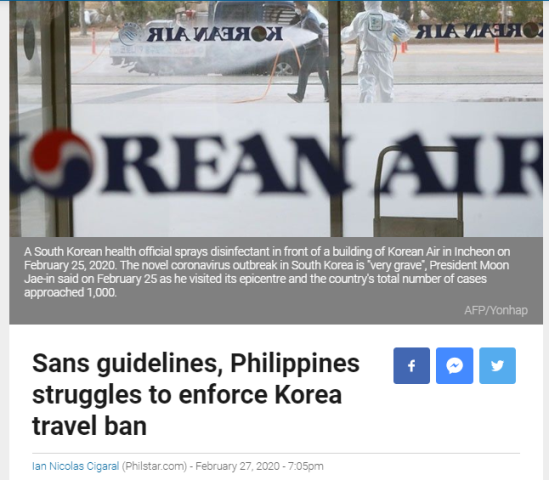Tall order? Questions about South Korea travel ban

WITH 64 countries other than China reporting confirmed cases, governments have stepped up efforts to combat the novel coronavirus (COVID-19). South Korea is second only to China in the number of cases, with 5,328 infected individuals as of March 4.
The Philippine government responded to the situation by restricting the entry of foreign nationals who had been to North Gyeongsang, the center of the outbreak in South Korea. Additionally, Filipino tourists going to any part of South Korea were prevented from doing so by a travel ban that was implemented and lifted within a week. Previously, the order to ban travelers coming from Taiwan was similarly announced and lifted within a short period.
The swiftness of the change in policy raises questions about the soundness of the decision-making process. But the media provided little discussion to examine the system of travel restrictions in connection with the virus.
CMFR monitored the coverage of three Manila-based broadsheets (Philippine Daily Inquirer, The Philippine Star, Manila Bulletin), four primetime news programs (ABS-CBN 2’s TV Patrol, CNN Philippines’ News Night , GMA-7’s 24 Oras and TV5’s Aksyon) and selected news sites from February 26 to March 3.
The coverage revealed a disjointed government approach to the travel ban despite the existence of an inter-agency task force composed of concerned departments and headed by the Department of Health (DOH). But the media did not point out the inconsistencies in the declarations of different officials. Neither did reporters ask how the task force was working together.
News accounts reported the travel ban order on February 26, quoting separate announcements from Health Secretary Francisco Duque and Presidential Spokesperson Salvador Panelo. Both said the decision was effective immediately.
The following day, some reports noted that the order had not been fully implemented. The Bureau of Immigration (BI) and commercial airlines said they did not have a copy of the written restriction guidelines yet. Quoting Ma. Rosario Vergeire, Assistant Secretary for Health, the Inquirer and CNNPhilippines.com reported that the document still needed one more signature to make the instructions official. In a separate online report, CNN Philippines quoted Duque complaining about “some groups becoming too technical” – referring to agencies who were waiting for the written order.
Curiously, the media, CNN Philippines included, did not make any effort to look into the problematic implementation nor to report the lack of internal agreement among officials from different agencies.
A notable exception, Philstar.com looked at the effect of the lack of guidelines, pointing out that commercial airlines were at a loss as to the implementation of the travel ban. TV Patrol also reported that there was no clarity about whether Filipinos transiting through South Korea for connecting flights were also prohibited from traveling.
The Department of Justice (DOJ), the parent agency of the BI, finally released the copy of the guidelines on February 28. On March 3, merely 4 days later, the task force announced the easing of restriction on Filipinos traveling to South Korea. Coverage stopped when Duque said that the country has a low fatality rate and that it had imposed strict protocols to contain COVID’s spread. However, reporters did not clarify what criteria were used for imposing and lifting travel bans.
Policies on public health, especially those dealing with epidemics, should be studied, referring as necessary to previous experience of widespread disease and the science on the subject. Public officials should be prepared to learn as much as they can about the different threats related to the virus. They should start by working together, so as not to add to public confusion and prevent effective action.
The media should not be afraid to point out the inefficiencies in the way government has acted on the current crisis. But that fundamental principle seems to have been mostly forgotten.
Leave a Reply